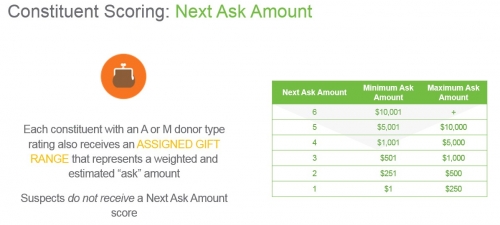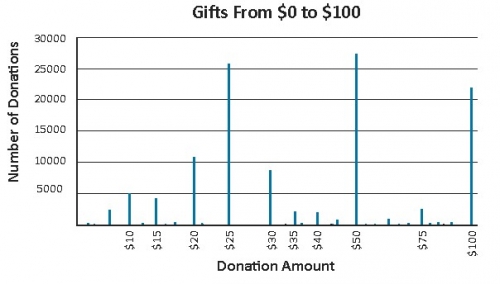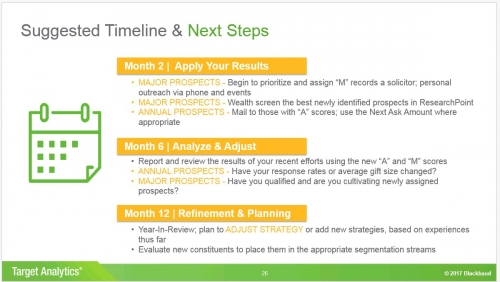Asking For – And Getting - Increased Gift Amounts: Best Practices For Using Your RE NXT Analytics Or Fundraising Essentials Next Ask Amount Scores
HERE'S THE SCENARIO:
You’ve just finished a lengthy conversation with your Target Analytics STRATEGIC CONSULTANT about the wealth ratings and analytics in RE NXT. Or, maybe you’ve just completed the Fundraising Essentials analytics training available from Blackbaud University…. either way, you’re ready to start using the returned results -- they're similar in their application. Raiser’s Edge NXT Essentials and Professional level subscribers, as well as, all Fundraising Essentials users, now have one of six NEXT ASK AMOUNT RANGES for each record from the analytics screening. Your Target Analytics Professional Services consultant presented a compelling case for using them to increase gift amounts from your donors. You also thought that the CHARTS AND DIAGRAMS discussed were interesting -- you had a spark of an idea -- but now it’s fading…
WHERE DO YOU START?!
BEST PRACTICES FOR USING NEXT ASK AMOUNTS
This sample matrix should look familiar. It’s like the one you reviewed during your conversation or training – though your actual numbers may vary from this sample.

The following strategies are TIME-TESTED AND PROVEN. You might start with one of these and then add more strategies later. I’ll also note that throughout my best practice examples, I’ve suggested GIFT DONATION AMOUNT ARRAYS using suggested gift amounts that Five Maples, a mail and marketing services firm, says are most-chosen by donors.
Strategy One - Increasing Annual Gift Amount for Low-End Current Donors with Next Ask Amount $1-$250
This strategy tests MOVING YOUR LOWEST LEVEL DONORS TO A HIGHER GIFT AMOUNT, yet still within Next Ask Amount $1-$250, if that’s their scoring designation. According to Five Maples, donors prefer round numbers, and since they’ve studied donation amount preferences, you’ll want to consider this demonstrated ask array formula for this strategy:
- Move givers below $25 to $25;
- Move $25 givers to $50;
- Move $50 givers to $100;
- Move $100 to $200;
- Move $200 to $250.


Source: How Ask Strings Work. Five Maples
- Select all donors that have made a gift in the past 18 months who also have a NEXT ASK AMOUNT OF $1-$250. The objective of this appeal is to upgrade current donors into a higher level of the assigned Next Ask Amount range.
- Then you’ll divide the group into the following sub-groups and CREATE A SEPARATE APPEAL CODE for each group so that you can analyze the results.
- $100, $75, $50 Ask – current donation is $.01-$49.99
- $200, $150, $100 Ask – current donation is $50-$99.99
- $250, $200 Ask – current donation is $100-$199.99
- $250 Ask – current donation is $200-$250
- Check out the BEST PRACTICES FOR APPEAL LETTERS toward the end of this article and use its advice to craft your solicitation language.
- Use a reply card and offer a REVERSED-ORDER OF GIFT AMOUNTS as suggested above – going from the highest request to the lowest. You can read an excellent article on anchoring ask array amounts here.
- Use the Appeal Performance Analysis Report filtering it on appeal codes so that you see how your STRATEGY ONE TEST letters performed. With results in hand, you’ll be prepared to make changes to your language or ask array amounts as necessary.
Strategy Two – Acquiring New Donors and Re-acquiring Lapsed Donors with Next Ask Amount $1-$250
Acquisition of new donors is a real concern for many organizations. Obtaining FIRST-TIME DONATIONS and re-acquiring lapsed donors (better known as “SYBUNTS”)(1) is a priority strategy within most charitable organization verticals. Make this your second test appeal.
- Select all non-givers and all past donors that have not made a gift in the past 18 months who also have a NEXT ASK AMOUNT OF $1-$250.
- Then you’ll divide the group into the following sub-groups:
- $100, $75, $50 Ask – no donation history
- $100, $75, $50 Ask – last donation was $.01-$49.99
- $200, $150, $100 Ask – last donation was $50-$99.99
- $250, $200 Ask – last donation was $100-$199.99
- $250 Ask – last donation was $200-$250
- Check out the BEST PRACTICES FOR APPEAL LETTERS toward the end of this article and use its advice to craft your solicitation language.
- Use a reply card that offers a REVERSED-ORDER OF GIFT AMOUNTS as suggested above – going from the highest request to the lowest.
- Use the Appeal Performance Analysis Report filtering it on appeal codes so that you see how your STRATEGY TWO TEST letters performed.
Strategy Three – Convert Lower Level Donors to a Monthly Donation to Significantly Increase Gift Amounts Using Next Ask Amount $251-$500
This strategy for using Next Ask Amount of $251-$500 seeks to convert current donors into making a monthly gift (also known as sustainer or recurring gifts) rather than a single yearly gift. The objective is two-fold. First to IMPROVE YOUR DONOR RETENTION RATES – up to 85% in some cases! Second, is to SIGNIFICANTLY INCREASE THE AVERAGE ANNUAL GIFT amounts for these donors. This strategy can be successful if used in direct mail, on-line and for telephone calling programs.
- Select all donors that have made a single gift of $200 or less in the past 18 months that also have a NEXT ASK AMOUNT OF $251-$500.
- You’ll only have one group and need just one appeal code for this test when you analyze the results.
- $40/Month, $35/Month, $30/Month, $20/Month Ask – current donation is $.01-$200
- Use a reply card or phone call script that offers a REVERSED-ORDER OF GIFT AMOUNTS as suggested above – going from the highest request to the lowest. The ask array makes it easy for donors to increase their total annual giving to between $250 - $500.
- Check out the BEST PRACTICES FOR APPEAL LETTERS toward the end of this article and use its advice to craft your solicitation language.
- Use the Appeal Performance Analysis Report so that you see how your STRATEGY THREE TEST letter or telephone campaign performed.
Strategy Four – Moving Mid-Level Donors to Major Gift Donors Using Next Ask Amount $1,001-$5,000
Here’s a strategy for using Next Ask Amount of $1,001-$5,000 in an upcoming appeal mailing or for GIFT OFFICERS MAKING FACE-TO-FACE SOLICITATIONS. The objective of this test is to move current mid-level donors with higher assessed capacity to an entry-level major gift.
- Select all donors that have made a single gift of $250-$749 in the past 18 months who also have a NEXT ASK AMOUNT $1,001-$5,000
- You’ll have two groups for this test and need two appeal codes when you analyze the results.
- $2,500, $2,000, $1,500, $1,000 – current donation is $250-$749.99
- $2,500, $2,000, $1,500, $1,000 – current donation is $750-$999.99

Source: How Ask Strings Work. Five Maples
- For donors with current donations of $250-$749.99: Create an APPEAL LETTER (or leave-behind letter in the case of face-to-face visits) that focuses on one or several specific funding priorities for the organization – acknowledging in the letter what the upgraded gift amount would allow the organization to accomplish.
- For donors with current donations of $750-$999.99: Have gift officers MAKE A PHONE CALL to these donors that first thanks them for their past gift and shares an example of how donations made a difference to one person’s life. Then tell the donor that the organization wants to make the same difference to many more people’s lives. Let the person on the other end of the line know that YOU'RE NOT ASKING FOR A GIFT TODAY – but rather that you’re reporting on the impact that their past giving has had. At the end of the call let them know that you’re sending a letter asking them to consider an upgraded gift and to expect to receive the letter shortly. Thank the donor again and let them know what a pleasure it was to speak with them personally on behalf of the executive team at the organization. (Be sure to have your talking points written out but do not read them word-for-word so to avoid sounding scripted.)
- If the donor does not answer the phone on the second attempt, leave a message that ACCOMPLISHES THE OBJECTIVES ABOVE but is less than 1 minute in length. (Have voicemail talking points ready to go!)
- Then, send the same letter as above to these people and have it HAND-SIGNED AND ADDRESSED by the gift officer making the call or leaving the voicemail.
- Check out the BEST PRACTICES FOR APPEAL LETTERS toward the end of this article and use its advice to craft your solicitation language.
- Use a reply card or pledge card that offers a REVERSED-ORDER OF GIFT AMOUNTS as suggested above – going from the highest request to the lowest.
- Use the Appeal Performance Analysis Report filtering it on appeal codes so that you see how your STRATEGY FOUR TEST letter performed with those that only received the letter and with those that received a phone call or voicemail message accompanied soon after by the hand-signed letter. You might want to also note which constituents were talked to personally from those that received a voicemail message to see how they differed or did not differ in their responses - you could use the same appeal code but with a unique PACKAGE CODE for this purpose.
A VARIETY OF STRATEGIES CAN BE TESTED AND USED OVER TIME
You may remember this slide from your consulting discussion or recorded strategy session.

There’s a lot of information on here and it might have seemed a little overwhelming when you first saw it. It’s time to look at it again. It contains similar strategies to those that you’ve just examined – it’s a useful guide as you think and plan how to best move forward with your Next Ask Amount results.
Next let’s look at how TOGETHER WITH A GREAT APPEAL LETTER, you can test ask array strings to raise more mission funds.
BEST PRACTICES FOR APPEAL LETTERS
Clarification, a fundraising firm, has an excellent article on WRITING SUCCESSFUL APPEAL LETTERS. I’ve shortened their suggestions for your review:
The Case
- OUTLINE A PROBLEM for your donor can solve
- Offer a simple, results-oriented SOLUTION
- Describe an attainable goal including what it will cost to SOLVE THE ISSUE
- Give an EXAMPLE of what the funds raised will accomplish
- Use a unit of accomplishment - $100 pays for 300 meals
The Ask
- MAKE AN UPFRONT ASK – early in the letter – again at the end
- Include a STRING OF GIVING LEVELS appropriate for each donor where possible – use your Target Analytics Next Ask Amount ranges for each segment of prospects or for each individual if you've mastered using “IF” fields in a variable text letter
- Increase the gift’s value through a CHALLENGE or matching gift strategy
- Include an urgent reason for your giving DEADLINE
The Tone
- USE "YOU" rather than “I” or “We” in your letter
- Write for ONE READER – read your letter aloud to “hear” your words
- Tell a story using a conversational tone and AVOID lots of data – again read your letter aloud to “listen” to your tone and choice of words
- Use visuals, such as PICTURES, where appropriate
- Ask the reader to JOIN YOU in accomplishing something amazing
- Assume your reader is about to give, and THANK HIM OR HER IN ADVANCE
However you choose to implement your Next Ask Amount results, you’ll want to CONSTANTLY BE TESTING new approaches and analyzing your results – keeping those that perform well, re-testing those that don’t perform well the first time, and adjusting weaker strategies in the future.
SUMMARY
When you received your Fundraising Essentials results or first looked at the wealth ratings and analytics in RE NXT you were told that PLANNING AND ORGANIZATION were the first and best next steps. The examples provided in this article should be considered and tested one or two at a time.
Testing new fundraising strategies, Next Ask Amount segments, current, lapsed or never-donor groups and new ask arrays TAKE TIME, deliberate ACTION, tracking and analysis – none of which occurs overnight or in a week’s time.
Here’s a reminder of the timeline and SUGGESTED NEXT STEPS we offered for project administration:

After completing the steps above its time to apply your results, then analyze and adjust your strategies and then plan to refine them again and plan more! … and, f you’d like to take a refresher on Fundraising Essentials or the wealth ratings and analytics in RE NXT you can do so anytime by following this link to recorded training.

P.S. If you haven’t already done so, PLEASE ALSO REGISTER with the Target Analytics Online Community, to stay connected! Learn BEST PRACTICES from fellow fundraisers & prospect researchers. You can also read articles from our TARGET ANALYTICS EXPERTS. It's a wonderful place to interact with us and other clients, so please join today!
(1) SYBUNT: a past donor that has not renewed his or her gift for some time who is expected to provide another gift in the future – “Some Year but Unfortunately Not This”


Leave a Comment